2014 FIAT 500L LIVING window
[x] Cancel search: windowPage 100 of 420
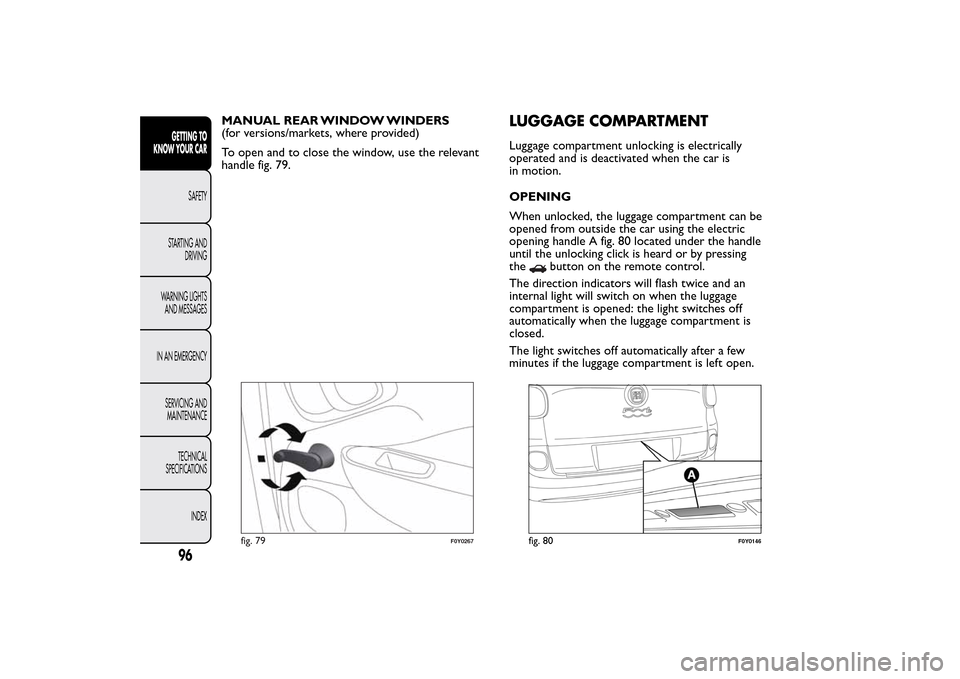
MANUAL REAR WINDOW WINDERS
(for versions/markets, where provided)
To open and to close the window, use the relevant
handle fig. 79.
LUGGAGE COMPARTMENTLuggage compartment unlocking is electrically
operated and is deactivated when the car is
in motion.
OPENING
When unlocked, the luggage compartment can be
opened from outside the car using the electric
opening handle A fig. 80 located under the handle
until the unlocking click is heard or by pressing
the
button on the remote control.
The direction indicators will flash twice and an
internal light will switch on when the luggage
compartment is opened: the light switches off
automatically when the luggage compartment is
closed.
The light switches off automatically after a few
minutes if the luggage compartment is left open.
fig. 79
F0Y0267
fig. 80
F0Y0146
96GETTING TO
KNOW YOUR CAR
SAFETY
STARTING AND
DRIVING
WARNING LIGHTS
AND MESSAGES
IN AN EMERGENCY
SERVICING AND
MAINTENANCE
TECHNICAL
SPECIFICATIONS
INDEX
Page 135 of 420
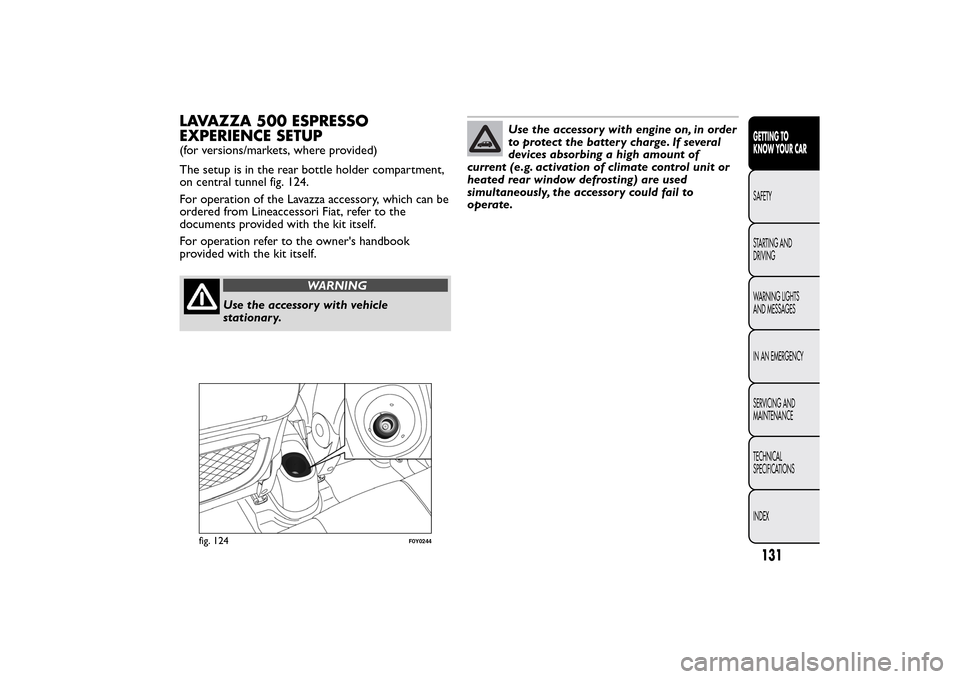
LAVAZZA 500 ESPRESSO
EXPERIENCE SETUP(for versions/markets, where provided)
The setup is in the rear bottle holder compartment,
on central tunnel fig. 124.
For operation of the Lavazza accessory, which can be
ordered from Lineaccessori Fiat, refer to the
documents provided with the kit itself.
For operation refer to the owner's handbook
provided with the kit itself.
WARNING
Use the accessor y with vehicle
stationar y.
Use the accessor y with engine on, in order
to protect the batter y charge. If several
devices absorbing a high amount of
current (e.g. activation of climate control unit or
heated rear window defrosting) are used
simultaneously, the accessor y could fail to
operate.
fig. 124
F0Y0244
131GETTING TO
KNOW YOUR CARSAFETY
STARTING AND
DRIVING
WARNING LIGHTS
AND MESSAGES
IN AN EMERGENCY
SERVICING AND
MAINTENANCE
TECHNICAL
SPECIFICATIONS
INDEX
Page 165 of 420

AIRBAGThe car is equipped with front airbags for driver and
passenger, driver's knee bag (for versions/markets,
where provided), seat-mounted side airbags for
driver's and passenger pelvis-chest-shoulder
protection (for versions/markets, where provided),
and window airbags for protecting the heads of front
and rear outer occupants.
The location of the airbags on the car is marked by
the writing "AIRBAG" in the middle of the steering
wheel, on the dashboard, on the side trim or on
a label placed next to the airbag deployment area.
FRONT AIRBAGS
The front driver/passenger airbags and the driver's
knee bag (for versions/markets, where provided)
protect the front seat occupants in the event of
frontal impacts of medium/high severity, by placing
the bag between the occupant and the steering
wheel or dashboard.
Therefore non-deployment in other types of impacts
(side impacts, rear shunts, roll-overs, etc.) does not
indicate a system malfunction.
Front (driver and passenger) airbags are not a
replacement for, but are complementary to, the seat
belts, which you are recommended to always wear,
as specified by law in Europe and most non-European
countries.
In the event of impact, those not wearing a seat belt
are projected forwards and may come into contactwith the bag which is still inflating. The protection
offered by the bag is compromised in these
circumstances.
Front airbags may not activate in the following
situations:
❒frontal impacts against highly deformable objects
not involving the front surface of the car (e.g.
wing collision against guard rail, etc.);
❒underride impacts with other vehicles or wedging
under protective barriers (e.g. trucks or guard
rails).
Failure to activate in the conditions described above
is due to the fact that they may not provide any
additional protection compared with seat belts, so
their activation would be inappropriate.
In these cases, non-deployment of the airbag does
not necessarily indicate a system malfunction.
WARNING
Do not apply stickers or other objects
on the steering wheel, on the dashboard
in the passenger airbag area, on roof side trims
or on the seats. Never put objects (e.g. mobile
phones) on the passenger side of the dashboard
since they could interfere with correct inflation
of the passenger airbag and also cause serious
injur y to the passengers.
161GETTING TO KNOW
YOUR CARSAFETYSTARTING AND
DRIVING
WARNING LIGHTS
AND MESSAGES
IN AN EMERGENCY
SERVICING AND
MAINTENANCE
TECHNICAL
SPECIFICATIONS
INDEX
Page 168 of 420

SIDE AIRBAGS: SEAT-MOUNTED SIDE
AIRBAG (for versions/markets, where
provided) AND WINDOW AIRBAG
To help increase occupants protection in the event of
certain side impact collisions, the car is equipped
with seat-mounted side airbags (for versions/
markets, where provided) and window airbag.
Seat-mounted side airbag
(for versions/markets, where provided)
These comprise two types of bags located in the
front seat backrests fig. 147 which protect the pelvis,
chest and shoulder area of the occupants in the
event of a side impact of medium/high severity.
Window bag
This comprises a "curtain" bag located along both
sides of the roof rails above the front and rear doors
fig. 148 covered by special trims.
It is designed to protect the head of front and rear
occupants in the event of a side impact, thanks
to the wide cushion inflation surface.
The deployment of seat-mounted side airbags in the
event of side impacts of low severity is not required.
In the event of a side impact, the system provides
best protection if the passenger sits on the seat in a
correct position, thus allowing correct window
bag deployment.
IMPORTANT Do not affix rigid objects to the
garment hooks or support handles.IMPORTANT Do not rest your head, arms or elbows
on the door, windows or the area in which the
window bag is located to avoid possible injury during
airbag inflation.
fig. 147
F0Y0090
164GETTING TO KNOW
YOUR CAR
SAFETY
STARTING AND
DRIVING
WARNING LIGHTS
AND MESSAGES
IN AN EMERGENCY
SERVICING AND
MAINTENANCE
TECHNICAL
SPECIFICATIONS
INDEX
IMPORTANT Never lean your head, arms or elbows
out of the window.
Page 178 of 420

Electrical devices
Only use electrical devices for the amount of time
needed. The heated rear window, additional
headlights, windscreen/rear window wipers and
heater fan need a considerable amount of energy,
therefore increasing fuel consumption (by up to 25%
in the urban cycle).
Climate control system
The use of the climate control system leads to higher
fuel consumption. If the temperature outside
permits, try to use ventilation only.
Devices for aerodynamic control
The use of non-certified devices for aerodynamic
control may adversely affect air drag and fuel
consumption.
DRIVING STYLE
Starting
Do not warm up the engine at low or high revs when
the car is stationary; this causes the engine to warm
up more slowly, thereby increasing fuel consumption
and emissions.
It is advisable to set off immediately and slowly,
avoiding high revs: this allows the engine to warm up
more quickly.Unnecessary actions
Avoid revving up when at traffic lights or before
stopping the engine. This and also double declutching
is absolutely pointless on modern cars and also
increases consumption and pollution.
Gear selection
Use a higher gear as soon as traffic and road
conditions allow. Using a low gear for faster
acceleration will increase consumption.
In the same way improper use of a high gear
increases consumption, emissions and engine wear.
Maximum speed
Fuel consumption increases considerably with speed.
Keep speed as constant as possible, avoiding
unnecessary braking and acceleration, which have a
significant cost in terms of both fuel consumption
and emissions.
Acceleration
Sudden acceleration has a very negative effect on fuel
consumption and emissions: accelerate gradually.
174GETTING TO KNOW
YOUR CAR
SAFETYSTARTING AND
DRIVINGWARNING LIGHTS
AND MESSAGES
IN AN EMERGENCY
SERVICING AND
MAINTENANCE
TECHNICAL
SPECIFICATIONS
INDEX
Page 185 of 420
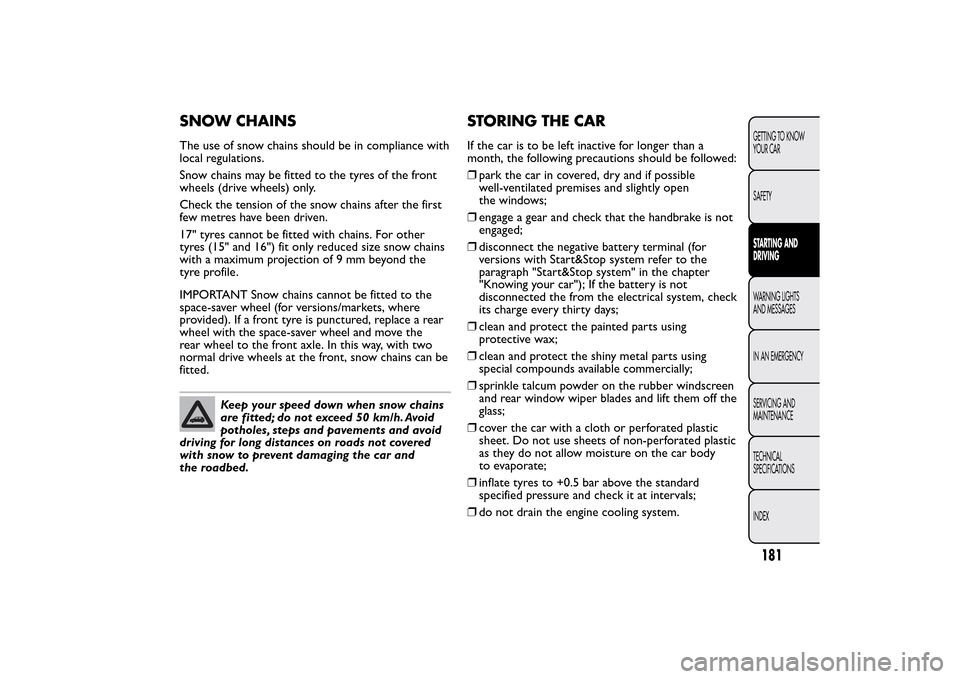
SNOW CHAINSThe use of snow chains should be in compliance with
local regulations.
Snow chains may be fitted to the tyres of the front
wheels (drive wheels) only.
Check the tension of the snow chains after the first
few metres have been driven.
17" tyres cannot be fitted with chains. For other
tyres (15" and 16") fit only reduced size snow chains
with a maximum projection of 9 mm beyond the
tyre profile.
IMPORTANT Snow chains cannot be fitted to the
space-saver wheel (for versions/markets, where
provided). If a front tyre is punctured, replace a rear
wheel with the space-saver wheel and move the
rear wheel to the front axle. In this way, with two
normal drive wheels at the front, snow chains can be
fitted.
Keep your speed down when snow chains
are fitted; do not exceed 50 km/h. Avoid
potholes, steps and pavements and avoid
driving for long distances on roads not covered
with snow to prevent damaging the car and
the roadbed.
STORING THE CARIf the car is to be left inactive for longer than a
month, the following precautions should be followed:
❒park the car in covered, dry and if possible
well-ventilated premises and slightly open
the windows;
❒engage a gear and check that the handbrake is not
engaged;
❒disconnect the negative battery terminal (for
versions with Start&Stop system refer to the
paragraph "Start&Stop system" in the chapter
"Knowing your car"); If the battery is not
disconnected the from the electrical system, check
its charge every thirty days;
❒clean and protect the painted parts using
protective wax;
❒clean and protect the shiny metal parts using
special compounds available commercially;
❒sprinkle talcum powder on the rubber windscreen
and rear window wiper blades and lift them off the
glass;
❒cover the car with a cloth or perforated plastic
sheet. Do not use sheets of non-perforated plastic
as they do not allow moisture on the car body
to evaporate;
❒inflate tyres to +0.5 bar above the standard
specified pressure and check it at intervals;
❒do not drain the engine cooling system.
181GETTING TO KNOW
YOUR CAR
SAFETYSTARTING AND
DRIVINGWARNING LIGHTS
AND MESSAGES
IN AN EMERGENCY
SERVICING AND
MAINTENANCE
TECHNICAL
SPECIFICATIONS
INDEX
Page 197 of 420
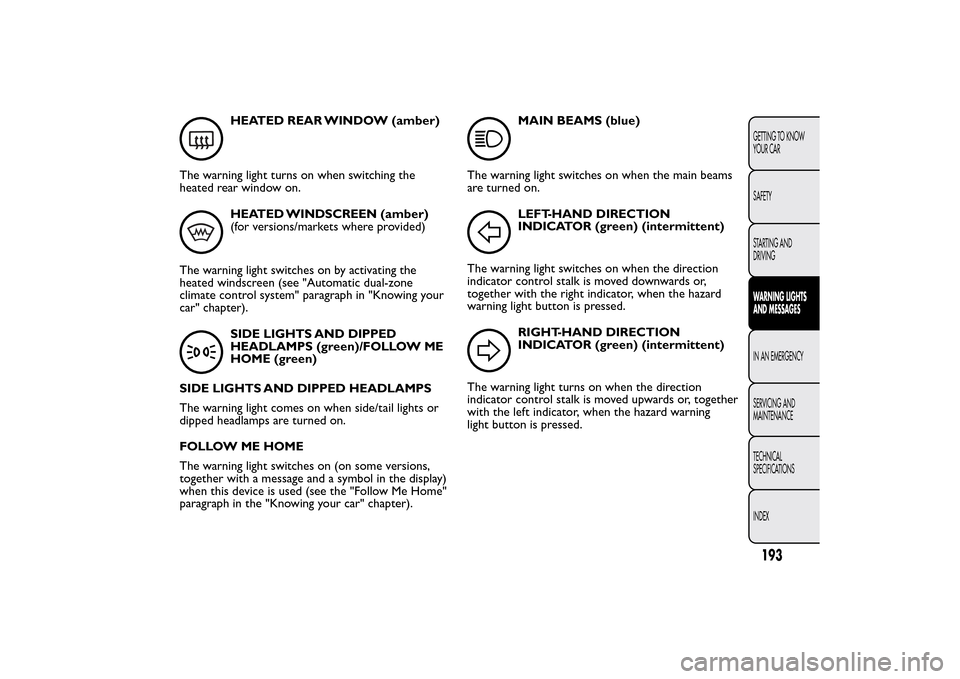
HEATED REAR WINDOW (amber)
The warning light turns on when switching the
heated rear window on.HEATED WINDSCREEN (amber)
(for versions/markets where provided)
The warning light switches on by activating the
heated windscreen (see "Automatic dual-zone
climate control system" paragraph in "Knowing your
car" chapter).SIDE LIGHTS AND DIPPED
HEADLAMPS (green)/FOLLOW ME
HOME (green)
SIDE LIGHTS AND DIPPED HEADLAMPS
The warning light comes on when side/tail lights or
dipped headlamps are turned on.
FOLLOW ME HOME
The warning light switches on (on some versions,
together with a message and a symbol in the display)
when this device is used (see the "Follow Me Home"
paragraph in the "Knowing your car" chapter).
MAIN BEAMS (blue)
The warning light switches on when the main beams
are turned on.LEFT-HAND DIRECTION
INDICATOR (green) (intermittent)
The warning light switches on when the direction
indicator control stalk is moved downwards or,
together with the right indicator, when the hazard
warning light button is pressed.RIGHT-HAND DIRECTION
INDICATOR (green) (intermittent)
The warning light turns on when the direction
indicator control stalk is moved upwards or, together
with the left indicator, when the hazard warning
light button is pressed.
193GETTING TO KNOW
YOUR CAR
SAFETY
STARTING AND
DRIVINGWARNING LIGHTS
AND MESSAGESIN AN EMERGENCY
SERVICING AND
MAINTENANCE
TECHNICAL
SPECIFICATIONS
INDEX
Page 231 of 420
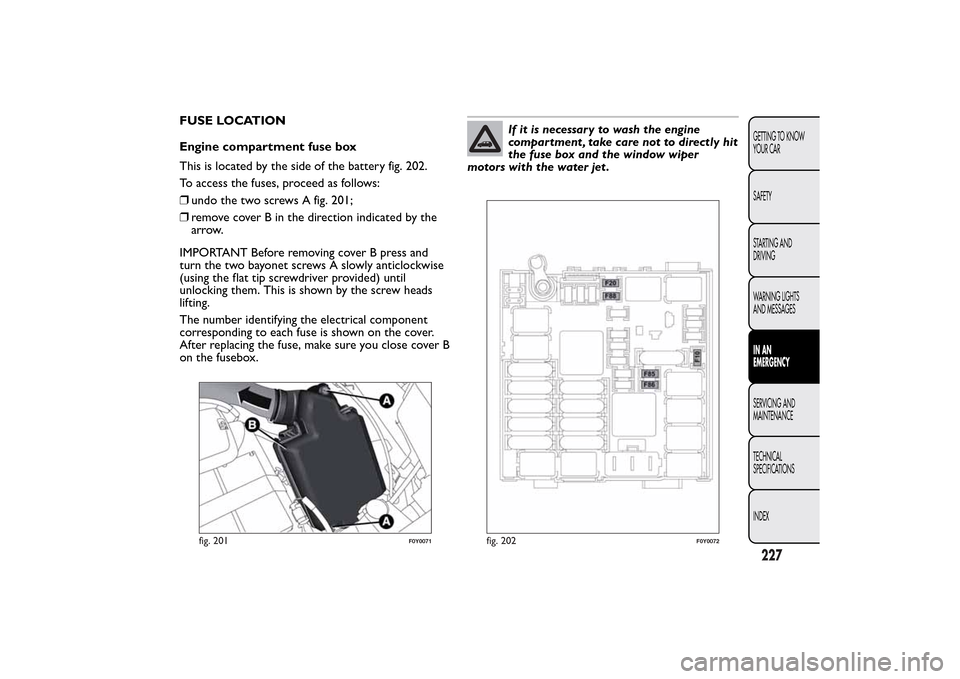
FUSE LOCATION
Engine compartment fuse box
This is located by the side of the battery fig. 202.
To access the fuses, proceed as follows:
❒undo the two screws A fig. 201;
❒remove cover B in the direction indicated by the
arrow.
IMPORTANT Before removing cover B press and
turn the two bayonet screws A slowly anticlockwise
(using the flat tip screwdriver provided) until
unlocking them. This is shown by the screw heads
lifting.
The number identifying the electrical component
corresponding to each fuse is shown on the cover.
After replacing the fuse, make sure you close cover B
on the fusebox.
If it is necessary to wash the engine
compartment , take care not to directly hit
the fuse box and the window wiper
motors with the water jet .
fig. 201
F0Y0071
fig. 202
F0Y0072
227GETTING TO KNOW
YOUR CAR
SAFETY
STARTING AND
DRIVING
WARNING LIGHTS
AND MESSAGESIN AN
EMERGENCYSERVICING AND
MAINTENANCE
TECHNICAL
SPECIFICATIONS
INDEX